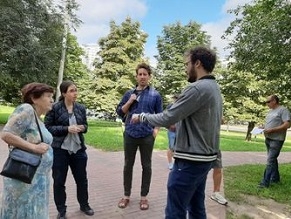|
Analytics

Freydl Reysman, a survivor of the Minsk ghetto, speaks with participants.
|
Acquainting Belarusian Jews with their Yiddish heritage
20.03.2020, Heritage In discussions of economics, tourism, industry, politics and even contemporary Jewish culture, the Baltic lands and recent changes in the Balkans are mentioned often, as is the profound influence of the countries in central Europe on issues affecting the European Union. Almost no one mentions Belarus, though.
True, in the Yiddish world, researchers travel to Belarus to find material on historical figures and events that took place there. But apart from the academic world, White Russia remains largely unknown to Jews, even though many of the cities and towns that once had flourishing Jewish communities can still be found there. Even Jews who know that their family comes from this area often say that they come from Poland, Lithuania, or Ukraine because they’re better acquainted with the Jewish and general history of those lands.
Few people know, though, that several Jewish organizations are currently active there. The Together Plan is a British charity organization that has been working for over a decade with Jewish communities in Belarus. In contrast to better known organizations, the Together Plan does more than provide humanitarian relief; it attempts to create deep personal relationships that are both socially and Jewishly meaningful, so that Jewish communities can better organize themselves vis-a-vis the values and interests of the local Jewish population.
The Together Plan recently introduced an innovative excursion to the historical city of Polotsk which helped introduce young Jews from England with the local Jewish population – a trip that was organized in conjunction with the European Association to Preserve and Promote the Jewish Cultural Heritage, which arranges similar programs in Western Europe.
Debra Brunner, the chairwoman of the charity organization in London, and Artur Livshyts, the representative in Minsk, don’t have a specific agenda. The plan is over time to establish a dynamic program, with an emphasis on Yiddish language and culture, so that people from abroad who are interested in history, genealogy, and the status of contemporary Jews could meet local Jews and Jewish groups. This would include discussions related to Yiddish literature, language, and culture – not only as a topic about the past, but also to give the participants a chance to hear the language; acquaint themselves with the rich Jewish culture in Belarus before the Holocaust; learn new Yiddish words and idioms, and how to construct sentences; learn songs and even converse a little in Mame-loshn.
For this reason, Brunner and Livshyts turned to a Yiddishist group in London called the Yiddish House. Together Plan provided stipends to four members of the Yiddish House, including yours truly, to go to Belarus.
In the capital city of Minsk, we met Freydl Reysman, a survivor of the Minsk Ghetto. She described what conditions were like for Jews in the ghetto. Together with a group of local Jewish residents we visited the Pit Memorial, where we read and explained the inscriptions written in Soviet-transcribed Yiddish. We were especially delighted to be able to speak some Yiddish with Mrs Reysman.
The organizers of our tour had planned a visit to the place where Chagall began his brilliant career as a world-famous painter – at his residence in Vitebsk. Arkady Shulman, a local historian who edits a magazine for the Jewish community of Vitebsk, took us around the city and told us about Chagall’s family and their experiences in Belarus.
Shulman seemed impressed that several participants in his tour were Yiddish speakers, like him. Likewise, the organizers from the Together Plan were surprised to discover that Shulman knew Yiddish – something they hadn‘t known before, despite the many years they had been working together. During the tour, the Yiddish House participants shared excerpts of a relatively unknown autobiographical poem that Chagall had written in Yiddish, which they then translated into English. Shulman translated it into Russian so that the local participants who knew neither Yiddish or English could understand it too.
Entering the woods encompassing Bronna Gora, the place where Germans murdered thousands of Jews from Brest and surrounding areas in a mass grave, the participants had another moving opportunity of connecting to Yiddish.
Near a small memorial, the group listened to a recording of poet Kadya Molodowsky reciting her Holocaust poem “God of Mercy”. We handed out fliers with the original poem in Yiddish, along with transliteration and an English translation. Molodowsky‘s poem was selected because she herself was born in Byaroza, a shtetl that lies a mere mile and a half from this terrible site. The participants later said that was a truly moving experience for them.
The Together Plan also organized a visit to Navahrudak, where a group of Jews had conducted several uprisings in the local ghetto. Several of the fighters had fled through a tunnel and became part of the renowned Bielski partisans, who lived and fought in the surrounding forests. The group visited the place where the Jews had entered the tunnel, a spot which now serves as a monument and a small museum.
When night fell the group returned to Minsk. In the car the Yiddishists passed out fliers with the words of the Partisan Hymn in Yiddish, beginning with the well-known line, “Never say you’re walking on your last road”, with transliterations. We talked about its author, Hirsch Glick, and sang the song for them. Some of the participants had heard the song, but never listened to the words, while others had never even heard of it. Everyone said that they were moved by the song, even if they heard it in a rather mundane setting – while sitting in a car on the way to Minsk.
By Arturo Kerbel Shein
Forward
|
|
